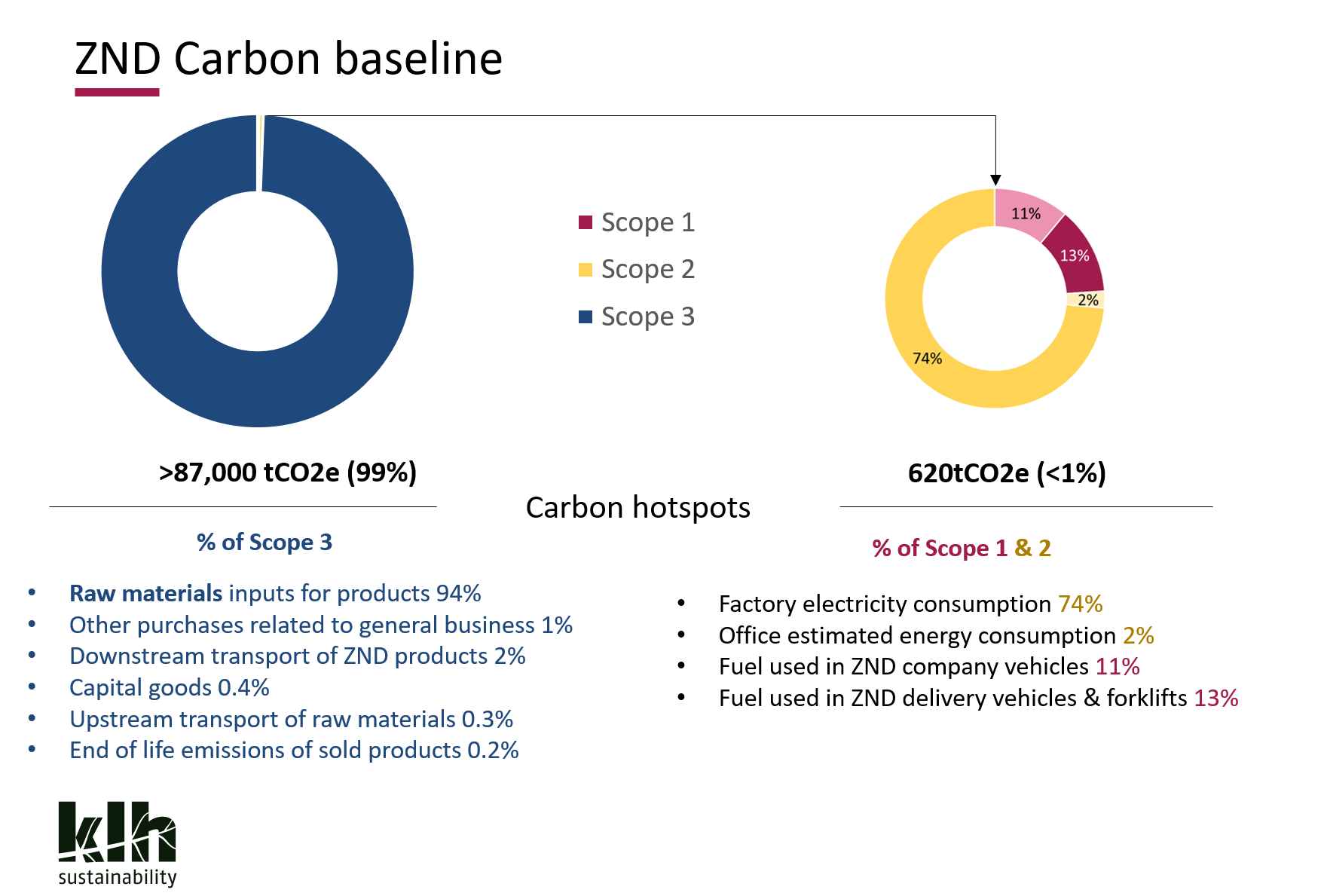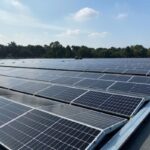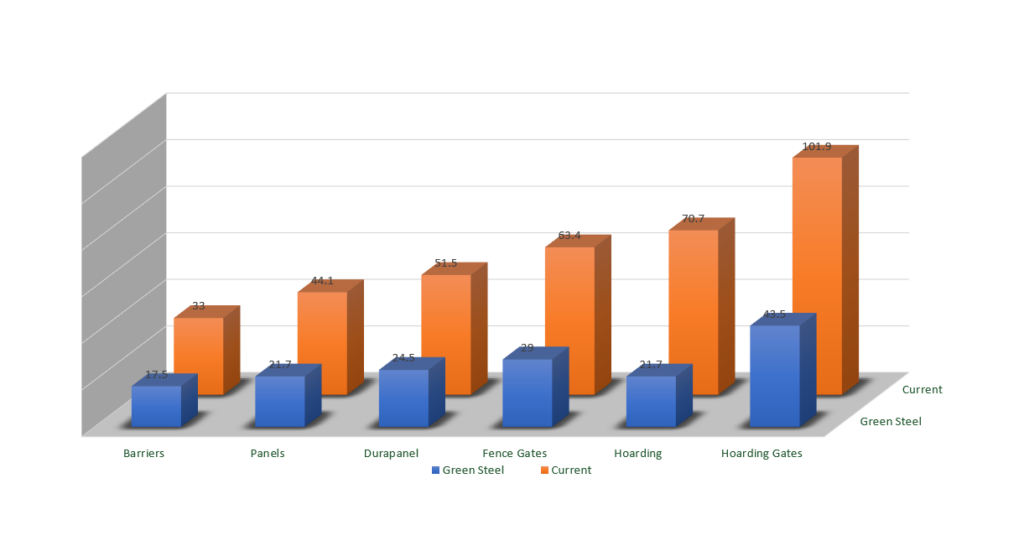ESG at ZND
Leading the Market to Net Zero
As the foremost supplier of temporary fencing and barriers in the UK, EU and North America, we’re acutely aware of ZND’s significant influence on both the industry and the broader social and environmental landscape. Our commitment to sustainability and to Environmental, Social, and Governance (ESG) principles is not merely a business strategy; it is integral to our aspiration to set the standard for responsible manufacturing.
Given ZND’s market prominence, any sustainability initiatives we undertake reverberate throughout the entire industry. Consequently, we are resolutely focused on shaping a future for the sector that is not only secure but also ethically sound and environmentally responsible to deliver a positive impact for all stakeholders.
Carbon Hotspots
The Challenge
In the field of temporary demarcation solutions, the use of steel is the industry standard due to its unparalleled strength, durability, and versatility. While alternative materials exist, none match steel’s unique ability to withstand diverse environmental conditions while providing the safety and reliability that our customers require. However, we acknowledge that steel production is carbon-intensive, contributing 63% of ZND’s carbon emissions.
Our aim therefore is to strike a responsible balance between the demands of high-quality, robust products and our commitment to sustainability, thereby minimising our carbon footprint while maintaining the integrity and effectiveness of our offerings to ensure the continued safety of the public.
The ZND Approach – Stonger Safer Smarter
To deliver on our sustainability objectives we are taking a direct and indirect approach.
Direct – The direct approach is focusing on what ZND as a business can do operationally to reduce carbon emissions, this can be broken down into three broad areas of focus;
- Raw Materials
- Energy Consumption
- Transportation
We aim to tackle the carbon emissions of our Raw Material requirements by investing in cleaner, more efficient manufacturing processes that minimise waste while also exploring avenues for using Green Steel.
We aim to tackle the carbon emissions of our Energy Consumption by investing in solar energy, sourcing Green Energy suppliers, improving manufacturing efficiencies and taking measures such as installing automatic lighting and energy efficient bulbs throughout our premises to minimise waste.
We aim to tackle the carbon emissions of our Transportation requirements by installing free to use charging points for staff, utilising electic vehicles where possible and moving towards a requirement for biofuel delivery vehicles.
Indirect – The indirect approach is focusing on what ZND as a business can do to reduce downstream carbon emissions, and here there are two broad areas of focus;
- Product Longevity
- New Products
- Transport Efficiency
Improving the service life of ZND products has a direct impact on the Raw Material and Energy demands placed on the market through manufacturing. The more use a panel and barrier can get, the less the demand to manufacture a replacement. As such we are exploring ways to improve the service life of all ZND products through either improved product spec, innovating on product design, developing new accessories, producing educational material for users and exploring a repair service that will see ZND Panels return to service.
As the largest supplier of temporary fencing and barriers in the UK, supplying many of the UK’s largest distributors, ZND have a unique opportunity to bring environmentally concious innovation to the market. Developing new products to compete with existing carbon intensive solutions has the potential to have massive downstream benefits.
Transportation is a major component of the rental industry. Temporary demarcation products are moved frequently, and require a lot of vehicular transportation throughout their life. Maximising load capacity is key to minimising the carbon emissions due to transportation, and ZND is exploring ways that this can be achieved.
The ZND Sustainability Journey
Follow the ZND journey to deliver on our areas of focus.
Sustainability Consultants Appointed
Appointed KLH Sustainability as consultants to set out ZND’s pathway to net zero. The consultation continued into 2023 and has helped ZND establish a baseline of carbon emissions, gain an understanding of our environmental impact and provided key insights on how we as a group can best deliver on environmental objectives.
Transportation (D) – Electric Vehicles – Charging Points Installed UK
Charging points installed at both the UK factory and UK head office. A number of company vehicles are transitioned to electric.
Energy Consumption (D) – Renewable Energy – Solar Installation
Installed 1,248 solar panels at ZND’s Rotherham factory. The installation will save around 75.92t in CO2 emissions per year. Upgrade to this installation began late 2023.
Product Longevity (ID) – Innovation – Durablock
Developed the Durablock to replace the standard concrete Ballast Block. The Durablock is designed to be far more robust, better able to survive impacts and environmental conditions, greatly improving service life and reducing the need for replacements.
Product Longevity (ID) – Knowledge – End-of-Life Study
We worked with our customer Speedy Services to assess 249 end-of-life panels. The findings of the investigation are being compiled into recommendations that are aimed at reducing avoidable damage to panels, thereby increasing their service life and reducing the need to source a carbon intensive replacement.
Energy Consumption (D) – Renewable Energy – Upgrade Solar Installation
Completing the addition of a further 1,200 panels at the Rotherham factory, upgrading the installation to a 999.54 kW system. The upgraded system will generate approximately 825.83 mWh of electricity per year, with 78% projected to be self-consumed equating to around 27% of total factory consumption.
The annual CO2 savings is estimated to be 192.42t.
Transportation (D) – Electric Vehicles – Electric Forklifts
Upon the expiration of the existing contract in November, the Rotherham factory has committed to transition its entire fleet of fossil fuel forklift trucks to new electric models. This change is expected to cut emissions by 62%.
Additionally, the factory intends to enhance these environmental benefits by adopting new processes that utilise the recently installed solar panels for charging the vehicles, thereby harnessing self-produced energy.
New Product (ID) – Innovation – SemPerFix
The new SemPerFix system is a semi-permanent fencing solution designed as an alternative to the existing industry standard that makes use of carbon intensive materials such as concrete.
The SemPerFix system is fully reusable, and can be taken from site to site as needed. From a user POV it not only avoids the need for concrete, but removes the foundation works required, saving time and resources.
Exploring Systemic Changes
In addition to the above listed work, we have also engaged with a number of other ideas to reduce our emissions and that of our customers.
“Green steel” refers to steel produced using methods that significantly reduce or eliminate the carbon emissions typically associated with traditional steel production. Traditional steelmaking is one of the world’s largest industrial sources of carbon emissions, primarily due to its reliance on coal in the blast furnace process.
Key aspects of green steel production include:
1. Use of Renewable Energy: Employing renewable energy sources like wind, solar, or hydroelectric power instead of fossil fuels to power the steelmaking process.
2. Hydrogen Reduction: Replacing coking coal with hydrogen in the steel reduction process. When hydrogen is used, the main byproduct of the reaction is water vapor rather than carbon dioxide.
3. Electric Arc Furnaces (EAF): Using EAFs which melt scrap steel using electricity, can be more environmentally friendly, especially when the electricity comes from renewable sources.
4. Carbon Capture and Storage (CCS): Implementing CCS technologies to capture and store the CO2 emissions produced during steelmaking.
5. Circular Economy Principles: Emphasising recycling and reusing steel, thus reducing the need for new steel production.
The development and adoption of green steel is crucial for reducing global carbon emissions, particularly in sectors like construction, automotive, and infrastructure, where steel is extensively used. The industry is evolving with technological advancements and increasing interest in sustainable practices. However, green steel production is still in its developmental stages and can be more expensive than traditional methods.
How it could apply to ZND
Raw material is the single largest contributing source of carbon emissions in the production of temporary fence panels, hoarding panels, barriers and associated products, therefore manufacturing using green steel can provide a substancial reduction in the carbon intensity of ZND products.
Based on initial investigations the emissions of the steel currently used is 2.280 kgCO2e per kg steel. Green steel stands at 0.797 kgCO2e per kg steel. A 65% reduction in carbon emissions per kg of steel.
If produced using green steel, ZND products would see the following reduction in their LCA;
- ~50% reduction for temporary fence panels
- ~46% reduction for barriers
Challenges
While green steel will drastically reduce the emissions per product, sourcing green steel is more expensive than regular steel, forcing up product prices for ZND customers. The price increase could perhaps be swallowed for rental companies where assets are expected to make a return over many years, however a price increase for resale stock would likely be more of an issue. This could result in products being made from separate steel sources.



